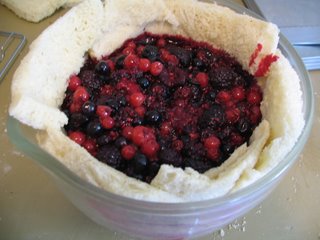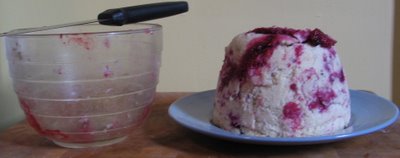Summer Pudding

I love the sniff of a new season around the corner, the stretch of the one you’re in, the memory of the one gone before. Those changes cheer and comfort me, and I love being bustled along by them. Moved into the next season. Even the one I’m not very good at: summer. Summer in steamy Philadelphia, at least. I wilt easily, go too pink, and am constantly asking my beloved if she thinks I have a fever. I ask this with one of my own damp paws raised to my forehead, my eyebrows hoiked high, fishing for sympathy. Exasperated, she tells me for the twelve hundredth time that you can’t perceive your own fever with another of your own identically temperatured body parts. A friend recently informed me that even another person’s hand is a prejudiced gauge and that the best way of checking someone’s temperature is to kiss their forehead. This I like and I make it my next request.
More often than not (all right, always), my ailment turns out to be feebleness in the face of humidity. This does not dent my love of the pleasures peculiar to summer – vampy tomatoes, soft fruits, lemony sorrel and snappy new garlic. Many dishes can only be made in the summer, but there is one that claims centre table to the season, and is indeed named for it: Summer Pudding. Summer Pudding is a delicacy that makes you nod your head in the deep appreciative realisation: this really is summer. You remembered it tasting this way. You had forgotten, but now you remember.
It’s also a recipe that has to remind you why it’s good, because it certainly sounds strange. And it’s deeply, eccentrically English. Describing it to Americans gets me those you-crazy-foreigner-from-the-land-of-bad-food looks. Observe: Summer Pudding is a mix of stewed summer fruits encased in mould of white bread. See? It sounds grotesque. It even looks grotesque as it emerges from its pudding basin, its clammy white jacket blotched with bloody seams.
Here’s how you make it:
First, you must go and live somewhere with a good supply of red and blackcurrants. This is not easy in this country. It took years of me living in various (mostly small college with big retirement home) towns before I landed on my lucky little feet here in Philadelphia, and this is the first place outside of England to show me such fruit. Once again the lovely ladies at the Fair Foods stand at Reading Terminal Market tempted me with their organic, local wares: quarts of not only the elusive red and blackcurrants, but handsome red and black raspberries too, the other essential berry for Summer Pudding. Once you have moved to the right currant supplying location, you need to gather your patience. Currant preparation takes time. The redcurrants come on lime-green stringy stalks, and you pull the small translucent berries off by dragging a fork down the stem. Very satisfying. But then you must check through to see if any tiny green sub-stems remain. Blackcurrants also have to be denuded of both their small stems and their substantial tails that look like crumpled brown-papery crowns. And the only way to do this is by hand – a modest amount of fingernail is useful for such plucking.
The currants picked and tumbled together with the raspberries, the fruit sits, or is “put up” with some sugar overnight, while you make some bread. The bread for this pudding must be just right. Nothing chewy and full of holes, but instead yeasty, very white and soft. So Mother (my sourdough starter) stays in the fridge, and out comes the yeast for what I would call a Crusty Bloomer.
 Hmm. This does take a lot of explaining. To name a loaf after an undergarment is one thing, to name it after a crusty undergarment is simply pushing everyone’s envelope. But a “bloomer” is a bloomer because it’s voluminous – billowy, rollicking even, vaudeville good. Then it has this wonderful crust that shatters under your knife. And when you make it for Summer Pudding, the crust has to come off, so you make the loaf and then you cut off this lovely crispness and you are forced to daub these trimmings with butter and jam and dispose of them right there and then. Forced, I tell you.
Hmm. This does take a lot of explaining. To name a loaf after an undergarment is one thing, to name it after a crusty undergarment is simply pushing everyone’s envelope. But a “bloomer” is a bloomer because it’s voluminous – billowy, rollicking even, vaudeville good. Then it has this wonderful crust that shatters under your knife. And when you make it for Summer Pudding, the crust has to come off, so you make the loaf and then you cut off this lovely crispness and you are forced to daub these trimmings with butter and jam and dispose of them right there and then. Forced, I tell you.The cook thus furnished, the pudding basin must be lined. The crustless slices of bread get fitted into the bowl, bits trimmed and squished into any gaps. To make the pieces stay in place, poke and press away with your fingers, because pressing is the key – practically the only – cooking process that turns these ingredients into pudding. Your bowl lined, the fruit goes into a pan with some sugar to be very lightly stewed.
 All you need to do is dissolve the sugar and nudge the fruits into giving up their juices – five minutes tops. Watch as the berries turn from a sugar-frosted mound into a vivacious slew. Once they’ve done this, reserve about a cup of their juice – tuck it away in the fridge, you won’t be using it for a few days yet. Turn half of the berries into the bread-lined pudding basin. This half way pause allows you to implement a trick I learned from Jane Grigson’s Summer Pudding recipe: place an extra slice of bread on top of the first half of the fruit, then continue filling with the rest. This extra, middle slice does not appear in most other recipes, but does an excellent job of securing the architecture of the pudding when you cut into it. Now the pudding needs a cap of bread; cut one to entirely cover the fruit, meeting the edges. Place a saucer on top of it all and a pile of weights on top of the saucer. I use the old weights from my beloved “Viking” scales, which I winkled out of the Age Concern Charity Shop on the Magdalen Roundabout in Oxford, but a big can of tomatoes would do well too. This is the pressing of what I spoke. PRESS YOUR PUDDING! It must be popped into the fridge and pressed and pressed some more. Leave the whole thing in the fridge until a worthy friend happens to come round. A day, two, or maybe three. All of this is Good Pressing Time. You cannot rush a Summer Pudding.
All you need to do is dissolve the sugar and nudge the fruits into giving up their juices – five minutes tops. Watch as the berries turn from a sugar-frosted mound into a vivacious slew. Once they’ve done this, reserve about a cup of their juice – tuck it away in the fridge, you won’t be using it for a few days yet. Turn half of the berries into the bread-lined pudding basin. This half way pause allows you to implement a trick I learned from Jane Grigson’s Summer Pudding recipe: place an extra slice of bread on top of the first half of the fruit, then continue filling with the rest. This extra, middle slice does not appear in most other recipes, but does an excellent job of securing the architecture of the pudding when you cut into it. Now the pudding needs a cap of bread; cut one to entirely cover the fruit, meeting the edges. Place a saucer on top of it all and a pile of weights on top of the saucer. I use the old weights from my beloved “Viking” scales, which I winkled out of the Age Concern Charity Shop on the Magdalen Roundabout in Oxford, but a big can of tomatoes would do well too. This is the pressing of what I spoke. PRESS YOUR PUDDING! It must be popped into the fridge and pressed and pressed some more. Leave the whole thing in the fridge until a worthy friend happens to come round. A day, two, or maybe three. All of this is Good Pressing Time. You cannot rush a Summer Pudding. 
Then when the worthy friend appears at your door (and wonder of wonders, ours arrived with two Tupperwares of “wineberries” she’d picked on the bike trail), slide a palette knife between the basin and the bread jacket, bending the blade down and around to reach under the bottom-soon-to-be-top of the pudding. Invert the basin onto a plate, and merrily conceal any rips by simply cascading the saved juice over the entire affair. It should look mostly scarlet, with just hints of white. A rose geranium leaf set atop, a jug of thick cream (not whipped) beside it, and you can carry the vibrant escutcheon of the season to your garden table.
 Sliced, this pudding reveals some marvelous, heretical transubstantiations: the bread tastes like cake, the fruit has become winey and the whole thing starts to look like a defiantly pagan, oppositely solsticed version of the traditional holly-topped Christmas Pudding. Blood red, bone white and green, this is the stuff that ballads are made of. And if the worthy friend never turns up, well, it will just have to be you and the pudding. Seasonal eating at its best.
Sliced, this pudding reveals some marvelous, heretical transubstantiations: the bread tastes like cake, the fruit has become winey and the whole thing starts to look like a defiantly pagan, oppositely solsticed version of the traditional holly-topped Christmas Pudding. Blood red, bone white and green, this is the stuff that ballads are made of. And if the worthy friend never turns up, well, it will just have to be you and the pudding. Seasonal eating at its best.
7 Comments:
So sad we weren't the worthy friends this time... :)
Looks great.
And if the unworthy friend shows up??? Something about the knife just made me have to ask...
Dear Metnym,
I do have a giant freezer in the basement for a reason.
Love,
Syllabub x
Hi Syllabub (what does that mean?),
nice to find your blog on the web.
Great to read about your recipes - you know how much I love food!! ;)
Friends of yours are right here next to me in Mainz, Germany, (guess who) and we're busy picking a domain name for my dental practice.. ;)
Any Ideas???
At any rate, I'll send people to your blog first - can you set up a link to my dental practice?? ;)
Hope you're well
xo
"The Dentist" :)
The writing is as good as the cooking. Thanks for this affirmation of the possibility of transformation on a very sticky summer day.
I'm still giddy at having been judged worthy. By immortalizing me thus, you have guaranteed yourself humble offerings of comestibles far into the future!
great post. love it!
Post a Comment
<< Home